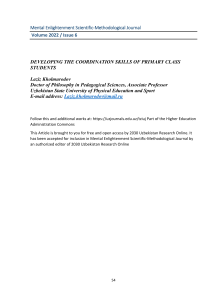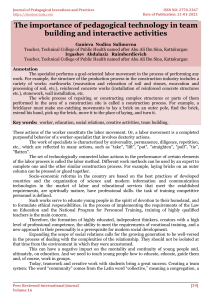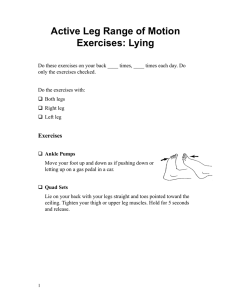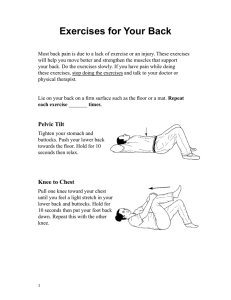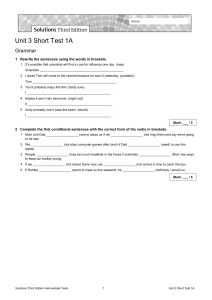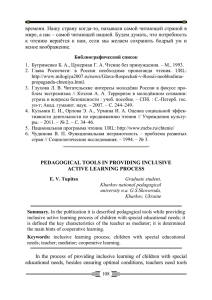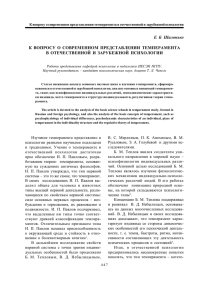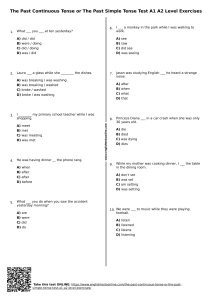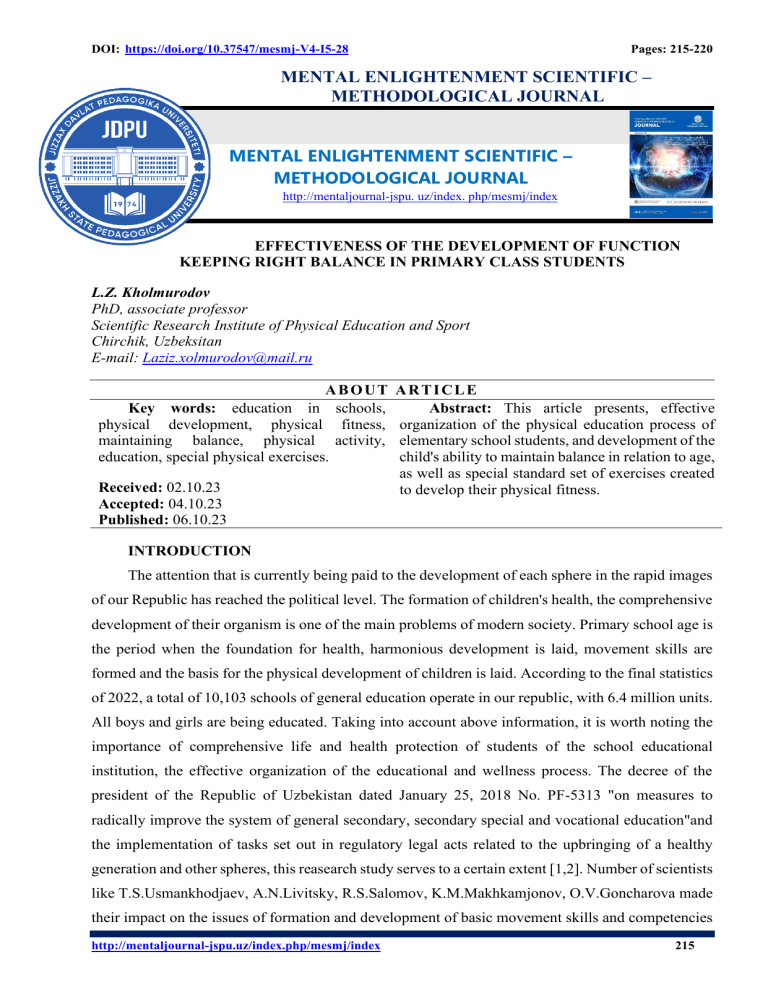
DOI: https://doi.org/10.37547/mesmj-V4-I5-28 Pages: 215-220 MENTAL ENLIGHTENMENT SCIENTIFIC – METHODOLOGICAL JOURNAL MENTAL ENLIGHTENMENT SCIENTIFIC – METHODOLOGICAL JOURNAL http://mentaljournal-jspu. uz/index. php/mesmj/index journal homepage: http://mentaljournal-jspu.uz/index.php/mesmj/about EFFECTIVENESS OF THE DEVELOPMENT OF FUNCTION KEEPING RIGHT BALANCE IN PRIMARY CLASS STUDENTS L.Z. Kholmurodov PhD, associate professor Scientific Research Institute of Physical Education and Sport Chirchik, Uzbeksitan E-mail: Laziz.xolmurodov@mail.ru ABOUT Key words: education in schools, physical development, physical fitness, maintaining balance, physical activity, education, special physical exercises. Received: 02.10.23 Accepted: 04.10.23 Published: 06.10.23 ARTICLE Abstract: This article presents, effective organization of the physical education process of elementary school students, and development of the child's ability to maintain balance in relation to age, as well as special standard set of exercises created to develop their physical fitness. INTRODUCTION The attention that is currently being paid to the development of each sphere in the rapid images of our Republic has reached the political level. The formation of children's health, the comprehensive development of their organism is one of the main problems of modern society. Primary school age is the period when the foundation for health, harmonious development is laid, movement skills are formed and the basis for the physical development of children is laid. According to the final statistics of 2022, a total of 10,103 schools of general education operate in our republic, with 6.4 million units. All boys and girls are being educated. Taking into account above information, it is worth noting the importance of comprehensive life and health protection of students of the school educational institution, the effective organization of the educational and wellness process. The decree of the president of the Republic of Uzbekistan dated January 25, 2018 No. PF-5313 "on measures to radically improve the system of general secondary, secondary special and vocational education"and the implementation of tasks set out in regulatory legal acts related to the upbringing of a healthy generation and other spheres, this reasearch study serves to a certain extent [1,2]. Number of scientists like T.S.Usmankhodjaev, A.N.Livitsky, R.S.Salomov, K.M.Makhkamjonov, O.V.Goncharova made their impact on the issues of formation and development of basic movement skills and competencies http://mentaljournal-jspu.uz/index.php/mesmj/index 215 Mental Enlightenment Scientific-Methodological Journal ISSN: 2181-1547 (E) / 2181-6131 (P) necessary for life in school-aged children; F.Khodzhaev, G.Q. Jalolova, F.A. on the theory of adaptation to health and exercise of elementary school students. The development of ways to develop physical fitness of students in the scientific research conducted by scientists and specialists such as Raimbekova, G.Kh. Salihova remains one of the urgent problems of the theory and practice of physical education today [5,6]. The purpose of the research: it consists in substantiating in experience the effectiveness of using balancing exercises to develop coordination skills of elementary school students. Tasks to accomplish in research study: ✓ study and analysis of scientific and methodical literature on the topic; ✓ study and analysis of the degree of influence on coordination abilities in the development of the balance sheet function of primary class students; ✓ to determine the level of development of coordination abilities of children 8-9 years old in pedagogical experience using special exercises for the development of the function of balancing. Research methods: analysis of scientific and methodological literature, pedagogical observation, pedagogical testing, metematic statistical methods. Organization of research. The experiment was conducted among primary school students of (160 people) in general education schools No. 13 and 14 in Chirchik city. Research studies conducted by L.P. Matveev, L.I. Penzulaeva, V.I. Lyakh, V.M. Shebeko, T.S. on the interrelated problem of the school education system between the physical development of primary school students and the development of coordination abilities through the formation of balance function. Scientists such as Usmankhodzhaev, A.N.Livitsky, R.S.Salomov, K.M.Makhkamjonov also conducted study researches regarding the issue. However, as a result of the rapid development of the theory and practice of modern physical education and the increase in the demands placed on education, there is a need for the use of modern methods to develop the basic motor skills of students, i.e., the ability to organize movement activities, the function of maintaining balance and coordination [8, 9]. Research results and its discussion. This is the optimal period for the growth of engaging a student in physical activities, and the formation of vital skills and abilities for the growing organism, especially when regularly engaged in physical education during the growing period of the child. In recent years, physical education issues have increasingly attracted the attention of the pedagogical, medical and parental communities. According to the latest data, the state of health of primary school students is considered unsatisfactory by many experts in the field, which worries teachers, doctors and the public. http://mentaljournal-jspu.uz/index.php/mesmj/index 216 Mental Enlightenment Scientific-Methodological Journal ISSN: 2181-1547 (E) / 2181-6131 (P) One of the most important tasks of physical education is the development of movement activity and function and the ability to control one's own movements. Laying the foundation for a person's physical development in the early stages of education serves as a guarantee of his further success in mental, work and sports activities. As a solution to the above-mentioned problems, the results of indicators of physical development of elementary school students were analyzed (see Table 1). Table 1 Analysis of indicators of physical development and functional status of elementary school students aged 8-9 years № 1 2 3 4 1 2 3 4 Age Tests Hight (см) Weight (кg) Grip strength Right hand (кg) Left hand (кg) Lung capacity During rest When inhaled When exhaling (см) Hight (см) Weight (кг) Grip strength: Right hand (кг) Left hand (кг) Lung capacity During rest When inhaled When exhaling (см) 8 years x±δ Boys 127,81±5,29 27,92±4,27 9 years x±δ 128,6±3,3 28,1±4,8 11,1±0,20 9,6±0,18 12,3±0,21 9,9±0,19 4,8±0,23 66,1±2,1 61,5±5,2 Girls 121,8±3,8 23,9±5,1 5,7±0,40 66,8±3,8 61,1±2,9 122,5±5,4 24,2±3,91 7,6±0,21 5,5±0,22 9,7±0,17 8,2±0,23 4,9±0,23 65,1±2,8 60,2±3,1 5,9±0,38 66,0±3,3 60,1±2,8 In order to determine the dependence of balance function on the level of development of coordination skills in elementary school students who participated in the pedagogical experiment, the studied indicators were tested. As a result of this test, children were allocated to control and experimental groups. In order for the average group results of control and experimental groups not to have statistically significant differences, a group of 20 ballads was formed, each using a pair sampling method. To evaluate the complex manifestation of coordination abilities of students, the control exercise "Three steps forward" was used. Also, to evaluate the ability to maintain dynamic balance, we used the balance exercise after turns on the gymnastic chair (right and left). We also used the control exercise "Standing on one leg" to assess balance function. The obtained results are presented in Table 2. http://mentaljournal-jspu.uz/index.php/mesmj/index 217 Mental Enlightenment Scientific-Methodological Journal ISSN: 2181-1547 (E) / 2181-6131 (P) Table-2 Analysis of comparative results of control and experimental group students at the beginning of the study Control exercises Turns on the gymnastic chair (right and left), s Standing on one leg, s Three flips forward, s Groups EG CG EG CG EG CG Statistical indicators x±δ t Р 4,9±0,7 0,8 ≥0,05 4,8±0,6 36,4±0,8 0,9 ≥0,05 31,7±0,5 5,8±0,6 0,10 ≥0,05 5,7±0,7 The results presented in the table above allow us to note that the average in terms of indicators studied in groups and the initial development of their coordination abilities are close to each other. The average showed that the differences were not statistically significant. The following balance exercises can be used in training with children of this age: maintaining balance after a sharp change in direction, turns after every two steps (left and right), and a complex of URMs while standing. Physical fitness and development of children is the main component of health. The physical development of children and the quality of training depends on the pedagogical correctness of the physical education process using modern methods and forms. Based on this, we have prepared the following balancing exercises for students' coordination skills. 1) The toes are touching the heels, the hands are on the waist and the eyes are closed. Keep balance in this position for 20-30 seconds; 2) Legs are in one line (legs alternate), hands are on the waist, and stand in this position for 2030 seconds. In the same way, but with eyes closed, stand for 15-20 seconds; 3) Stand with legs together, hands on the waist, on tiptoes for 15-20 seconds. The same, but with eyes closed for 15-20 seconds; 4) The hands are on the waist, the left leg is bent at the knee, and the right leg is standing on the tip for 15-20 seconds. The legs are swapped. The same, but with closed eyes; 5) Bending the body in a horizontal position 5-8 times with legs together, standing on tiptoes (beacon-like movements, one bend per second). Just like that, but with closed eyes; 6) Legs in one line (alternating legs), hands on the waist, bending to the left and right 8-10 times (beacon-like movements, one bending per second) Same thing, but with eyes closed. In addition, the experiment included balance exercises for students of the experimental class after sudden changes in the direction of movement, and turning exercises for walking, running and jumping. http://mentaljournal-jspu.uz/index.php/mesmj/index 218 Mental Enlightenment Scientific-Methodological Journal ISSN: 2181-1547 (E) / 2181-6131 (P) Table 3 Analysis of the comparative results of control and experimental group students at the end of the study Control exercises Groups Turns on the gymnastic chair (right and left), s Standing on one leg, s EG CG EG CG EG CG Three flips forward, s Statistical indicators x±δ t Р 4,0±0,5 5,2 ≤0,05 4,6±0,8 44,3±0,7 3,4 ≤0,05 36,5±0,6 11,4±0,7 3,6 ≤0,05 6,8±0,4 At the end of the pedagogical study, a final control test was carried out. The dynamics of changes in the indicators of the development of coordination skills in primary students in the process of pedagogical experience is presented in Table 3. 6,6 7 5,2 6 5 4,1 4 3 2 1,2 0,9 0,3 1 0 Уч умболоқ олдинга Бир оёқда туриш Назорат гуруҳи Гимнастика ўриндиғида бурилишлар Тажриба гуруҳи Diagram 1. At the end of the study, a comparative analysis of the results of the development of students' coordination abilities, s. The results of the obtained data showed that the results of the students in the experimental group showed changes in all indicators compared to the control group. Based on this, the results of performing the exercise "Gymnic seat turns" were 0.9 seconds in the experimental group and 0.3 seconds in the control group. The results of the second "Standing on one leg" exercise were 6.6 seconds and 4.1 seconds, respectively. When analyzing the results of performing the exercise "three flips forward", it was found that the experimental group improved by 5.2 seconds, and the control group improved by 1.2 seconds (see diagram 1). Thus, the conducted pedagogical research, the methodology developed by us allows to more effectively increase the level of development of coordination skills in elementary school students with the help of balance exercises. http://mentaljournal-jspu.uz/index.php/mesmj/index 219 Mental Enlightenment Scientific-Methodological Journal ISSN: 2181-1547 (E) / 2181-6131 (P) The results of the analysis of the sources of scientific and methodical literature and the implementation of pedagogical research showed that one of the tasks of developing coordination skills in children of this age is to organize specific movement activities: feeling the direction of movement in space, accuracy, balance, etc. are very important for some types of sports and professional activities. To develop balance, it is recommended to perform various gymnastic elements (push-ups, twists, flips) and special, so-called rotation exercises: movements of turning the head, turns in place (turning the body from one leg to the other). The ability to maintain balance is developed on the basis of the improvement of reflector mechanisms during the formation of the vestibular analyzer. The sensitive period for the development of this ability is from 7 to 12 years. REFERENCES 1. Ўзбекистон Республикасининг “Жисмоний тарбия ва спорт тўғрисида”ги қонуни (янги тахрири), 2015 йил 5 сентябрь. 2. Ўзбекистон Республикаси Президентининг “Умумий ўрта, ўрта махсус ва касб-ҳунар таълими тизимини тубдан такомиллаштириш чора-тадбирлари тўғрисида”ги Фармони. 2018 йил 25 январдаги ПФ-5313-сон 3. Холмуродов Л. З. Мактабгача ёшдаги болаларнинг жисмоний сифатларини ривожлантириш //Fan-Sportga. – 2021. – №. 1. – С. 46-49. 4. Холмуродов Л. З. Ёш футболчиларнинг жисмоний қобилиятлари ва техник-тактик тайёргарликларини ёшга нисбатан ривожлантириш //Fan-Sportga. – 2021. – №. 3. – С. 8-10. 5. Холмуродов Л. З. Развитие координационных способностей у детей дошкольного возраста с использованием специальных физических упражнений Development of coordination abilities in preschool children using special physical exercises //ББК 75.1 А-437. – 2019. – С. 655. 6. Холмуродов Л. З. Болаларнинг статик мувозанат сақлаш қобилиятини ривожлантириш //Фан-cпортга. – 2019. – №. 4. – с. 2-6. 7. Лях В. И. Развитие координационных способностей у дошкольников. изд., «Спорт» М.: 2016. – 96 с. 8. Usmonxajayev T.S., Islomova S.T. Maktabgacha ta’lim muassasalarida jismoniy tarbiya T.: “Ilm Ziyo” nash. 2006. – 184 с. 9. Xolmurodov L. Developing the coordination skills of primary class Students. Mental Enlightenment Scientific-Methodological Journal. Volume 2022 / Issue 6. 55-63 pg. http://mentaljournal-jspu.uz/index.php/mesmj/index 220
